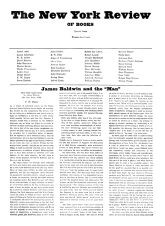The Heritage Press has reissued in three volumes its indispensable edition of Gibbon’s Decline and Fall of the Roman Empire, with an introduction by the late Professor Bury and with his version of the text. This edition had long been out of print, available only sporadically on the secondhand market at about fifty dollars. The Heritage Press edition is to be commended for its handsome and clear typography and design in which Gibbon’s notes appear, as they should, in the margins of each page adjacent to the textual passages which they are meant to amplify.
It is unfortunate, on the other hand, that the publishers chose to illustrate their edition with engravings by Piranesi who, though he was Gibbon’s contemporary, approaches Roman antiquity in a somewhat more valetudinarian spirit than Gibbon would have liked. Furthermore, Piranesi’s engravings, which show the antiquities as they appeared in the eighteenth century, half-buried and often in ruins, surrounded by contemporary buildings and out of scale, are, for all their brilliance, hardly as illuminating as reconstructions of the original states of these monuments would have been and still less illuminating than reproductions of the coins, medals, and trophies to which Gibbon continually refers and on which his argument so greatly depends. Finally, the publishers have chosen to print the engravings in a brown tone rather than in Piranesi’s own black, with the result that the reproductions are not at all representative of the originals.
It is also to be regretted that the publishers did not take this opportunity to replace Philip Guedalla’s introduction, which was no good to begin with and is now hopelessly out of date, with something more apposite and scholarly. This new printing might also have been the occasion to give Professor Bury’s admirable text, which is now many years old, to a modern scholar for further emendation.
Nevertheless, the new edition, whatever its faults—and these include the binding, which is too flimsy for volumes this large—is the best we have and perhaps the best we shall have for some time to come. It is to be hoped, however, that in future printings the publishers will replace the present end-paper maps, which are very sparse, with maps that are more informative.
This Issue
February 1, 1963



